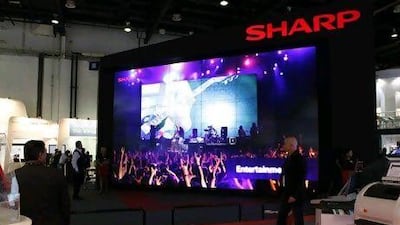When it comes to the flat-screen business, how big is big enough?
Q&A: More businesses are turning to videowalls to drive up business. Here's how.
Last Updated: May 03, 2011
What exactly is a video wall? It's a giant screen made up of smaller flat-screen panels.
Why would a business want one? Many buy one to try to drive up revenues. There was one recently installed in Boston's Prudential Center, which stands 3 metres tall and features stock exchange feeds and other information aimed at drawing more customers to a local bank.
What other kinds of organisations in this region could use one to boost business? Airports make for a good fit. This year, the McCarran International Airport in Las Vegas erected the largest video wall in a US airport. It features 100 screens and measures 627 square feet.
Will that really lift business? Randall Walker, the airport's aviation director, thinks so. He has said the video wall's "eye-catching stature allows the airport and advertisers to speak to travellers from all corners of the world, and also presents a unique opportunity to increase revenue".
What should business owners consider before buying one? Be sure the video-wall panels offer ultra-wide viewing angles. And look at the width of the seams that separate each screen.
Last week, the electronics maker Sharp launched a Dh500,000 (US$136,130) TV in the Middle East, complete with a 108-inch interactive touch-screen panel.
The thought of having one's eyes and fingers glued to that much digital real estate might tickle many home theatre enthusiasts in the Emirates, although the set is actually being targeted at organisations such as universities, conference hotels, shopping centres and even boardrooms.
"It's entirely interactive," says Ravinder Kumar, the deputy general manager for the business solutions division at Sharp.
The industry is seeking to provide technology like this that would, for instance, allow a shopper to home in on what kinds of sales might be going on in particular stores.
Or in the case of a smaller set that might lay flat on a table, for business professionals to write and highlight text in a meeting then e-mail the notes to themselves later.
These kinds of innovations are part of an attempt to capitalise on what experts say is a growing, $250 million information display panel market in the Middle East.
Some of the latest products were shown in Dubai last week at Palme Middle East, a specialised audio-visual exhibition.
Video-wall panels are another growing area in this market, and were displayed by makers such as Prysm.
They are increasingly used by businesses for digital advertising, and in auditoriums, museums, airports and hospitals.
As well as providing all sorts of information to visitors, they can bring in extra revenues through advertisers keen on marketing to captivated audiences.
Top 5: Record-shattering screens
1: Largest display of screens: 4,138 7-inch monitors (Italy)
2: Largest LED screen: 250 metres by 30 metres (China)
3: Longest TV screen: 107.52 metres by 10.88 metres (UAE)
4: Largest plasma HDTV screen: 152 inches (Japan)
5: Largest LCD HDTV screen: 108 inches (Japan)
Source: Guinness World Records
But panels built into a video wall are not cheap. Sharp, which has a new line of 60-inch panels, sells them for Dh50,000 each.
In October, the company pieced together dozens of LCD monitors at Gitex in Dubai, in what became the biggest video wall on display in this region, at 360 inches.
"They're larger than life," says Mr Kumar.
The Quote: "A wide screen just makes a bad film twice as bad" Samuel Goldwyn, the famous film producer

